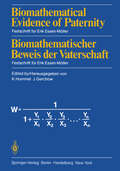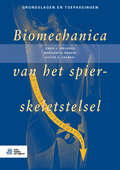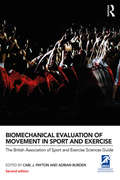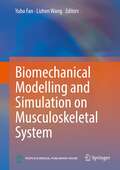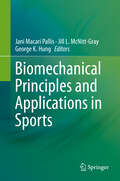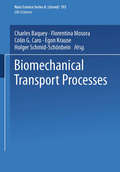- Table View
- List View
Biomateriomics (Springer Series in Materials Science #165)
by Steven W. Cranford Markus J. BuehlerBiomateriomics is the holistic study of biological material systems. While such systems are undoubtedly complex, we frequently encounter similar components -- universal building blocks and hierarchical structure motifs -- which result in a diverse set of functionalities. Similar to the way music or language arises from a limited set of music notes and words, we exploit the relationships between form and function in a meaningful way by recognizing the similarities between Beethoven and bone, or Shakespeare and silk. Through the investigation of material properties, examining fundamental links between processes, structures, and properties at multiple scales and their interactions, materiomics explains system functionality from the level of building blocks. Biomateriomics specifically focuses the analysis of the role of materials in the context of biological processes, the transfer of biological material principles towards biomimetic and bioinspired applications, and the study of interfaces between living and non-living systems. The challenges of biological materials are vast, but the convergence of biology, mathematics and engineering as well as computational and experimental techniques have resulted in the toolset necessary to describe complex material systems, from nano to macro. Applying biomateriomics can unlock Nature’s secret to high performance materials such as spider silk, bone, and nacre, and elucidate the progression and diagnosis or the treatment of diseases. Similarly, it contributes to develop a de novo understanding of biological material processes and to the potential of exploiting novel concepts in innovation, material synthesis and design.
Biomathematical Evidence of Paternity / Biomathematischer Beweis der Vaterschaft: Festschrift for Erik Essen-Möller / Festschrift für Erik Essen-Möller
by K. Hummel J. GerchowBiomathematik: Eine Einführung für Biologen und Mediziner
by Werner TimischlAufbauend auf der Schulmathematik, d.h. auf niedrigem Abstraktionsniveau, und mit starkem Anwendungsbezug, d.h. mit vielen Beispielen und Aufgaben, wird das mathematische Grundwissen für Biologen (aber auch Mediziner und Agrarwissenschaftler) vermittelt: - Die Beschreibung und Verarbeitung von Beobachtungsdaten - Die für die biologische Praxis wichtigsten Funktionstypen - Die Anpassung von Funktionen an vorgegebene Daten - Die Erfassung dynamischer Prozesse durch Differenzen- und Differentialgleichungen sowie - Programmunterstütztes Problemlösen (mit Basic). Die zahlreichen, vollständig durchgerechneten Beispiele sowie die mit Lösungen versehenen Aufgaben am Ende eines jeden Abschnittes helfen mit, Anfangsschwierigkeiten leichter zu überwinden, und unterstützen insbesondere auch eine Aneignung des Stoffes im Selbststudium.
Biomathematik für Mediziner: Begleittext zum Gegenstandskatalog (Heidelberger Taschenbücher #164)
by Kollegium Biomathematik Kollegium Biomathe NwBiomathematik für Mediziner: Begleittext zum Gegenstandskatalog (Heidelberger Taschenbücher #164)
by Kollegium Biomathematik Kollegium Biomathe NwDie Aufnahme der Biomathematik in das Studium der Medizin soll die Studierenden mit der Denkweise in einem Fach bekannt machen, dessen Methoden und Schlußweisen in immer stärkerem Maß Eingang in die Medizin finden, vor allem - zur Planung von Versuchen, - zur Bereitstellung objektiver Entscheidungsgrundlagen und - zur Komprimierung von Daten. Die Beschäftigung mit der Biomathematik kann nach Meinung der Autoren ein wichtiger Beitrag sein zur Verbreitung des Wissens um die Möglichkeiten der Mathematik und zur Vermeidung der Fehler, die häufig bei der kritiklosen Anwendung ihrer Methoden oder der kritiklosen Übernahme von "Ergebnissen" gemacht werden. Die moderne Medizin ist gekennzeichnet durch wachsende diagno stische und therapeutische Anforderungen. Die Zunahme an Metho den und Daten führt zu immer stärkerer Spezialisierung und Abglie derung der medizinischen Fachdisziplinen. Die dadurch auftretenden Probleme, vor allem der Integration und Kommunikation, sollen mit Hilfe der Medizinischen Informatik bewältigt werden. Das Buch ist eine Ergänzung der Vorlesung und der praktischen Übungen. Sein Inhalt beschränkt sich daher im wesentlichen auf den Gegenstandskatalog für den Ersten Abschnitt der Ärztlichen Prüfung (1. Auflage, Dezember 1973) und die dazu notwendigen theoretischen Grundlagen. Die Lernziele sind im Text am Rand numeriert. Für interessierte Leser ist auf weiterführende Literatur verwiesen.
Biomeasurement: A Student's Guide to Biological Statistics
by Dawn HawkinsStatistical analysis allows us to attach meaning to data that we have collected; it helps us to understand what experimental results really mean, and to assess whether we can trust what experiments seem to be telling us. Yet, despite being a collection of the most valuable and important tools available to bioscientists, statistics is often the aspect of study most feared by students. Biomeasurement offers a refreshing, student-focused introduction to the use of statistics in the study of the biosciences. With an emphasis on why statistical techniques are essential tools for bioscientists, the book develops students' confidence to use and further explore the key techniques for themselves. Beginning by placing the role of data analysis in the context of the wider scientific method and introducing the student to the key terms and concepts common to all statistical tools, the book then guides the student through descriptive statistics, and on to inferential statistics, explaining how and why each type of technique is used, and what each can tell us in order to better understand our data. It goes on to present the key statistical tests, walking the student step-wise through the use of each, with carefully-integrated examples and plentiful opportunities for hands-on practice. The book closes with an overview of choosing the right test to suit your data, and tools for presenting data and their statistical analyses. Written by a talented educator, whose teaching has won praise from the UK's Quality Assurance Agency for Higher Education, Biomeasurement is sure to engage even the most wary of students, demonstrating the power and importance of statistics throughout the study of bioscience. Online resources: The online resources to accompany Biomeasurement include: For students: · Screencast walkthroughs for SPSS and R. · Online glossary and flashcard glossary. · Data sets, for use in statistical analysis software packages. · Help sheets offering concise guidance on key techniques and the use of statistical analysis software packages. · Interactive calculation sheets to help students carry out key statistical tests quickly and easily in Excel, without the need for other software. · Full-text versions of Literature Link articles from OUP Journals. For registered adopters of the book: · Additional exercises, to supplement those in the book, and suggested tutorial assignments. · Figures from the book, available for download. · PowerPoint presentation outlines for each chapter.
Biomeasurement: A Student's Guide to Biological Statistics
by Dawn HawkinsStatistical analysis allows us to attach meaning to data that we have collected; it helps us to understand what experimental results really mean, and to assess whether we can trust what experiments seem to be telling us. Yet, despite being a collection of the most valuable and important tools available to bioscientists, statistics is often the aspect of study most feared by students. Biomeasurement offers a refreshing, student-focused introduction to the use of statistics in the study of the biosciences. With an emphasis on why statistical techniques are essential tools for bioscientists, the book develops students' confidence to use and further explore the key techniques for themselves. Beginning by placing the role of data analysis in the context of the wider scientific method and introducing the student to the key terms and concepts common to all statistical tools, the book then guides the student through descriptive statistics, and on to inferential statistics, explaining how and why each type of technique is used, and what each can tell us in order to better understand our data. It goes on to present the key statistical tests, walking the student step-wise through the use of each, with carefully-integrated examples and plentiful opportunities for hands-on practice. The book closes with an overview of choosing the right test to suit your data, and tools for presenting data and their statistical analyses. Written by a talented educator, whose teaching has won praise from the UK's Quality Assurance Agency for Higher Education, Biomeasurement is sure to engage even the most wary of students, demonstrating the power and importance of statistics throughout the study of bioscience. Online resources: The online resources to accompany Biomeasurement include: For students: · Screencast walkthroughs for SPSS and R. · Online glossary and flashcard glossary. · Data sets, for use in statistical analysis software packages. · Help sheets offering concise guidance on key techniques and the use of statistical analysis software packages. · Interactive calculation sheets to help students carry out key statistical tests quickly and easily in Excel, without the need for other software. · Full-text versions of Literature Link articles from OUP Journals. For registered adopters of the book: · Additional exercises, to supplement those in the book, and suggested tutorial assignments. · Figures from the book, available for download. · PowerPoint presentation outlines for each chapter.
Biomechanica van het spier-skeletstelsel
by Chris J. Snijders Margareta Nordin Victor H. FrankelHet succesvolle Amerikaanse boek Basic biomechanics of the skeletal system is inmiddels verschenen in onder andere de Zweedse, Chinese en Japanse vertaling. Ook de Nederlandse vertaling en bewerking werd enthousiast ontvangen.Deze vierde, licht gewijzigde druk van Biomechanica van het spier-skeletstelsel geeft opnieuw op heldere wijze en met vele illustraties inzicht in de belangrijkste biomechanische begrippen die men tegenkomt in de diagnostiek, de behandeling, de revalidatie en de preventie van letsel van het bewegingsapparaat.Het boek bevat hoofdstukken over heup, knie, enkel, voet, schouder, elleboog, pols,hand, halswervelkolom, lendewervelkolom en bekken. Hierin worden de mechanische eigenschappen besproken van bot, kraakbeen, pezen en ligamenten. Bovendien worden er relaties gelegd tussen een ongunstige belasting en het ontstaan van klachten, zoals lage rugpijn en een tenniselleboog.Biomechanica van het spier-skeletstelsel bevat veel voorbeelden uit de praktijk, die bijeen zijn gebracht door een orthopedisch chirurg, een fysiotherapeut en een ingenieur. Lichaamshouding staat centraal bij de onderwerpen bukken en tillen, staan, zitten en liggen. De houding van het lichaam houdt immers ten nauwste verband met de eisen die men moet stellen aan schoenen, stoelen, bedden en werkplekken.De veelheid aan informatie maakt het boek geschikt als leerboek voor verscheidene studierichtingen (medici en paramedici). Zelfstudie wordt vergemakkelijkt door middel van oefenopgaven met essay- en multiple-choicevragen.Prof.dr.ir. C.J. Snijders, de Nederlandse vertaler en bewerker van deze publikatie, is als hoogleraar verbonden aan het Erasmus MC, Universitair Medisch Centrum Rotterdam en aan de Faculteit Industrieel Ontwerpen van de Technische Universiteit Delft. Hij publiceerde talrijke wetenschappelijke artikelen in nationale en internationale tijdschriften.
Biomechanical Analysis of Nursing Tasks for Physical Relief by Collaborative Robotics
by Anna BrinkmannMusculoskeletal disorders are among the most significant health risks contributing to the global decline in mental health and physical performance. Occupations with high physical work demands, such as patient handling in nursing, are associated with high rates of long-term absenteeism and disability due to musculoskeletal pain and disorders. Robotic assistance systems are revolutionizing bedside care and could provide a healthy future for caregivers. For the first time, the potential of a collaborative robotic system to assist nurses in a manual patient handling scenario has been quantified. Using the system significantly reduced the maximum effort required, resulting in physical relief. It demonstrates the feasibility of robot-assisted patient repositioning and highlights the need for interdisciplinary research to adaptively respond to the individual needs and functional abilities of nurses. This work provides a foundation for future research and practical implementation. The use of robotics is innovative, contemporary, widely applicable, and promising for reducing existing risk factors in nursing care.
Biomechanical Aspects of Soft Tissues
by Benjamin Loret Fernando Manuel SimoesBiomechanics applies the laws and techniques of mechanics in the study of biological systems and related phenomena. Biomechanics uses mathematical and computational tools such as model construction of musclo-skeletal system, body fluid circulation, to aid medical diagnosis, therapeutics and surgery planning, designing of prostheses and implants or in tissue engineering. Present book targets specific topics pertaining to the biomechanics of soft tissues. Subjects addressed includes solids and multi-species mixtures as open systems: a continuum mechanics perspective; electro-chemo-mechanical couplings: tissues with a fixed electric charge and growth of biological tissues.
Biomechanical Aspects of Soft Tissues
by Benjamin Loret Fernando Manuel SimoesBiomechanics applies the laws and techniques of mechanics in the study of biological systems and related phenomena. Biomechanics uses mathematical and computational tools such as model construction of musclo-skeletal system, body fluid circulation, to aid medical diagnosis, therapeutics and surgery planning, designing of prostheses and implants or in tissue engineering. Present book targets specific topics pertaining to the biomechanics of soft tissues. Subjects addressed includes solids and multi-species mixtures as open systems: a continuum mechanics perspective; electro-chemo-mechanical couplings: tissues with a fixed electric charge and growth of biological tissues.
Biomechanical Evaluation of Movement in Sport and Exercise: The British Association of Sport and Exercise Sciences Guide (BASES Sport and Exercise Science)
by Carl J. Payton Adrian BurdenNow in a fully updated and revised new edition, this is still the only up-to-date, practical guide to the use of technology in sport and exercise biomechanics. It includes detailed explanations of the key theory underlying biomechanics testing and measurement, along with advice on choosing equipment and using it effectively. The second edition includes two completely new chapters on qualitative movement analysis and the assessment of movement coordination, and covers every key functional area in the biomechanics curriculum, including: motion analysis using video and on-line systems measurement of force and pressure measurement of torque and power using isokinetic dynamometry electromyography computational simulation and modelling of human movement research methodologies data processing. Published in association with the British Association of Sport and Exercise Sciences (BASES), it includes contributions from world leading researchers and pioneers in the field of sport and exercise biomechanics. Biomechanical Evaluation of Movement in Sport and Exercise is a must-have text for all biomechanics laboratories and for any student undertaking a research project or course in methods, measurement or analysis in biomechanics.
Biomechanical Evaluation of Movement in Sport and Exercise: The British Association of Sport and Exercise Sciences Guide (BASES Sport and Exercise Science)
by Carl J. Payton Adrian BurdenNow in a fully updated and revised new edition, this is still the only up-to-date, practical guide to the use of technology in sport and exercise biomechanics. It includes detailed explanations of the key theory underlying biomechanics testing and measurement, along with advice on choosing equipment and using it effectively. The second edition includes two completely new chapters on qualitative movement analysis and the assessment of movement coordination, and covers every key functional area in the biomechanics curriculum, including: motion analysis using video and on-line systems measurement of force and pressure measurement of torque and power using isokinetic dynamometry electromyography computational simulation and modelling of human movement research methodologies data processing. Published in association with the British Association of Sport and Exercise Sciences (BASES), it includes contributions from world leading researchers and pioneers in the field of sport and exercise biomechanics. Biomechanical Evaluation of Movement in Sport and Exercise is a must-have text for all biomechanics laboratories and for any student undertaking a research project or course in methods, measurement or analysis in biomechanics.
Biomechanical Modelling and Simulation on Musculoskeletal System
by Yubo Fan Lizhen WangThe book involves the basic principles, methods, anatomy and other knowledge for modelling and simulation of the musculoskeletal system. In addition, abundant examples are presented in detail to help readers easily learn the principles and methods of modelling and simulation. These examples include the impact injury and clinical application of the modelling of bone and muscle. In terms of impact injury, the book introduces the biomechanical simulation of impact injury in head, spine, ankle, knee, eyeball and many other parts. With regard to clinical application, it explores the optimization of orthopaedic surgery and design of orthopaedic implants. Readers will find this is a highly informative and carefully presented book, introducing not only the biomechanical principles in the musculoskeletal system, but also the application abilities of modelling and simulation on the musculoskeletal system.
Biomechanical Modelling at the Molecular, Cellular and Tissue Levels (CISM International Centre for Mechanical Sciences #508)
by Gerhard A. Holzapfel Ray W. OgdenBiomechanical Models for Soft Tissue Simulation (ESPRIT Basic Research Series)
by Walter Maurel Yin Wu Nadia Magnenat Thalmann Daniel ThalmannAn overview of biomechanical modeling of human soft tissue using nonlinear theoretical mechanics and incremental finite element methods, useful for computer simulation of the human musculoskeletal system.
Biomechanical Principles and Applications in Sports
by Jani Macari Pallis Jill L. McNitt-Gray George K. HungThis book provides an overview of biomedical applications in sports, including reviews of the current state-of-the art methodologies and research areas. Basic principles with specific case studies from different types of sports as well as suggested student activities and homework problems are included. Equipment design and manufacturing, quantitative evaluation methods, and sports medicine are given special focus. Biomechanical Principles and Applications in Sports can be used as a textbook in a sports technology or sports engineering program, and is also ideal for graduate students and researchers in biomedical engineering, physics, and sports physiology. It can also serve as a useful reference for professional athletes and coaches interested in gaining a deeper understanding of biomechanics and exercise physiology to improve athletic performance.
Biomechanical Systems: Techniques and Applications, Volume III: Musculoskeletal Models and Techniques
by Vijay K. Goel J. Lawrence Katz Roderic S. Lakes Eihab Muhammed Abdel-Rahman Barry S. Myers Robert D. Harten Allan F. Tencer Alain Meunier Sheu-Jane Shieh A. E. Engineering Cornelius T. Leondes Chris Van Ee David Hawkins Mark C. Zimmerman Nicole M. Grosland Mohamed Samir Hefzy Chimba MkandawireBecause of developments in powerful computer technology, computational techniques, advances in a wide spectrum of diverse technologies, and other advances coupled with cross disciplinary pursuits between technology and its greatly significant applied implications in human body processes, the field of biomechanics is evolving as a broadly significant area. This Third Volume presents the advances in widely diverse areas with significant implications for human betterment that occur continuously at a high rate. These include dynamics of musculo-skeletal systems; mechanics of hard and soft tissues; mechanics of muscle; mechanics of bone remodeling; mechanics of implant-tissue interfaces; cardiovascular and respiratory biomechanics; mechanics of blood flow, air flow, flow-prosthesis interfaces; mechanics of impact; dynamics of man machine interaction; and numerous other areas. The great breadth and depth of the field of biomechanics on the international scene requires at least four volumes for adequate treatment. These four volumes constitute a well integrated set that can be utilized as individual volumes. They provide a substantively significant and rather comprehensive, in-depth treatment of biomechanic systems and techniques that is most surely unique on the international scene.
Biomechanical Systems: Techniques and Applications, Volume III: Musculoskeletal Models and Techniques
by Cornelius LeondesBecause of developments in powerful computer technology, computational techniques, advances in a wide spectrum of diverse technologies, and other advances coupled with cross disciplinary pursuits between technology and its greatly significant applied implications in human body processes, the field of biomechanics is evolving as a broadly significant area. This Third Volume presents the advances in widely diverse areas with significant implications for human betterment that occur continuously at a high rate. These include dynamics of musculo-skeletal systems; mechanics of hard and soft tissues; mechanics of muscle; mechanics of bone remodeling; mechanics of implant-tissue interfaces; cardiovascular and respiratory biomechanics; mechanics of blood flow, air flow, flow-prosthesis interfaces; mechanics of impact; dynamics of man machine interaction; and numerous other areas. The great breadth and depth of the field of biomechanics on the international scene requires at least four volumes for adequate treatment. These four volumes constitute a well integrated set that can be utilized as individual volumes. They provide a substantively significant and rather comprehensive, in-depth treatment of biomechanic systems and techniques that is most surely unique on the international scene.
Biomechanical Transport Processes (Nato Science Series A: #193)
by Charles BaqueyProceedings of a NATO ARW held in Cargese, France, October 9-13, 1989
Biomechanics: Selected Proceedings of the Fifth Meeting of the European Society of Biomechanics, September 8–10, 1986, Berlin, F.R.G. (Developments in Biomechanics #3)
by Georg Bergmann R. Kölbel A. RohlmannBy definition Biomechanics is the application of engineering methods to study the mechanical aspects of living beings. Mostly the life scientists have the questions but lack of the specialized methods. The engineers on the other hand can handle very specialized equipment and methods, but lack in the biological thinking. If both sides are able to adapt to each other, Biomechanics is a classical field of interdis ciplinary cooperation. In the beginning, most biomechanical research was done in the field of orthopaedics. But other areas like cardiovascular research, dentistry, sports and many others gain increasing importance. This situation is clearly reflected in this book, which contains a selected number of papers which were presented at the Fifth Meeting of the European Society of Biomechanics, held in September 1986 in Berlin. Meanwhile these meetings have become a well accepted forum and a place of interdis ciplinary discussion for scientists in Biomechanics on the one side and surgeons and other peoples interested in biome chanical solutions on the other. It is the third time that the proceedings are published as a book and the editors are sure that this volume will help to establish this series "Developement in Biomechanics" as a valuable tool for all people involved in Biomechanics. The Fifth Meeting of the ESB also marks the tenth anniversary in the short history of the European Society of Biomechanics.
Biomechanics: Proceeding of the First Rock Island Arsenal Biomechanics Symposium April 5–6, 1967 (pdf)
by David BootzinBiomechanics: Mechanical Properties of Living Tissues
by Y. C. FungThe motivation for writing aseries ofbooks on biomechanics is to bring this rapidly developing subject to students of bioengineering, physiology, and mechanics. In the last decade biomechanics has become a recognized disci pline offered in virtually all universities. Yet there is no adequate textbook for instruction; neither is there a treatise with sufficiently broad coverage. A few books bearing the title of biomechanics are too elementary, others are too specialized. I have long feIt a need for a set of books that will inform students of the physiological and medical applications of biomechanics, and at the same time develop their training in mechanics. We cannot assume that all students come to biomechanics already fully trained in fluid and solid mechanics; their knowledge in these subjects has to be developed as the course proceeds. The scheme adopted in the present series is as follows. First, some basic training in mechanics, to a level about equivalent to the first seven chapters of the author's A First Course in Continuum Mechanics (Prentice-Hall,lnc. 1977), is assumed. We then present some essential parts of biomechanics from the point of view of bioengineering, physiology, and medical applications. In the meantime, mechanics is developed through a sequence of problems and examples. The main text reads like physiology, while the exercises are planned like a mechanics textbook. The instructor may fil1 a dual role: teaching an essential branch of life science, and gradually developing the student's knowledge in mechanics.

